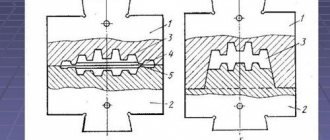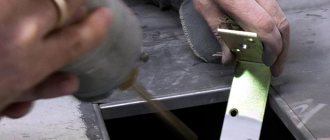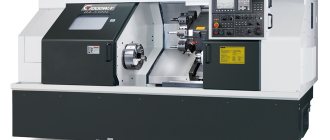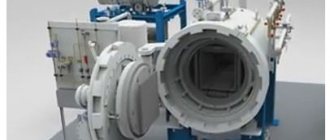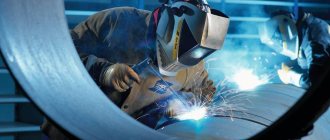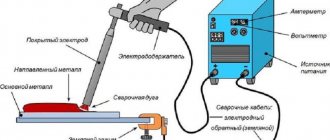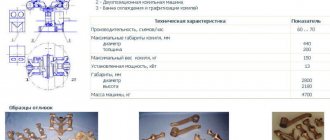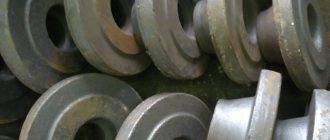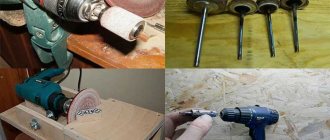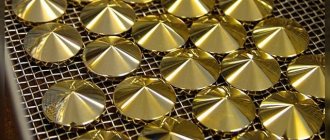Using modern technologies in metalworking, industrial enterprises create various parts and assemblies of any complexity. They are in demand in instrument making, mechanical engineering, furniture and many other industries. We are talking about a variety of products, from ordinary nails to turbines and pipes.
Enterprises use several techniques and high-performance equipment for these tasks. First of all, these are automatic and screw-cutting lathes.
The former are used for in-line mass production of various parts. The second is for small-scale or piece production. Countersinks, drills, cutters, taps and other tools are used to process workpieces. The simplest models are controlled manually by the operator. More advanced devices work in conjunction with computer equipment using a pre-prepared program. In particular, CNC machines are used.
Also, to change the geometry, mechanical and other properties, casting, welding, and pressure treatment, including pressing and stamping, are used. The choice of method depends on the technical specifications facing the enterprise, deadlines, required speed and productivity.
Foundry
Casting is the very first method that people began to use. The first was copper, and the smelting of iron from ore in a cheese furnace began in the 12th century BC. e. Modern technologies make it possible to obtain various alloys, refine and deoxidize metal. For example, deoxidation of copper with phosphorus makes it more plastic, and remelting in an inert environment increases electrical conductivity.
The latest advances in metallurgy have been the emergence of new alloys. New, higher quality grades of high-alloy stainless steel of the austenitic and ferritic class have been developed. More durable and corrosion-resistant heat-resistant, heat-resistant, acid-resistant and food-grade steels AISI 300 and 400 series have appeared. Some alloys have been improved and titanium has been introduced into their composition as a stabilizer.
In non-ferrous metallurgy, alloys with optimal characteristics for a particular industry have also been obtained. Recycled general-purpose aluminum 1105, high-purity aluminum A0 for the food industry, airlines, among which the most popular grades in the aviation industry are AB, AD31 and AD 35, seawater-resistant ship aluminum 1561 and AMg5, weldable aluminum alloys alloyed with magnesium or manganese, heat-resistant aluminum such as AK4. A wide range of copper-based alloys - bronze and brass - also have characteristic features and satisfy all the needs of the national economy.
Main directions of development of metalworking
The main directions of development of metalworking around the world are:
- development of new materials and alloys;
- improvement of metalworking methods and methods;
- increase in productivity, product quality and ore efficiency.
The development of new materials and alloys is one of the promising areas that determines the positive development of the metalworking industry. Scientific developments related to the creation of new alloys make it possible to obtain materials with certain quality characteristics. These experiments make it possible to achieve higher strength and weldability of the metal material, absence of brittleness, and increased corrosion resistance. Steel, cast iron, polyethylene, polyvinyl chloride and other materials, while maintaining their properties, gain the ability to be modified using new technologies. The opportunity to improve and automate metal processing of parts opens up new prospects for manufacturers and consumers. The use of program control allows you to increase productivity, improve product quality, achieve more accurate compliance with specified parameters, and significantly minimize human participation in complex processes.
Formation of technological characteristics of the alloy
The modern metal market offers a variety of semi-finished products made from various steel and non-ferrous alloys. Moreover, the same brand can be offered in different technological states.
Heat treatment
Through heat treatment, the alloy can be brought to the most rigid and durable state or, conversely, to a more ductile state. Solid state “T” - thermally hardened, achieved by heating to a certain temperature and subsequent sharp cooling in water or oil. Soft state “M” - thermally annealed, when after heating the cooling is slow. For aluminum, there are also thermal methods of natural and artificial aging.
For each brand, its own heat treatment modes have been determined, the influence of stress on corrosion properties has been studied, which also makes it possible to formulate technological processes.
Pressure hardening
This method was known to our ancestors. Blacksmiths increased the density of the material by forging it cold. This was called unriveting a scythe or blade. Today this process is called cold hardening, which is designated “N” in the marking of rolled products. Modern technologies make it possible to obtain mechanical hardening of any degree with high precision. For example, “H2” is half hardening, “H3” is third hardening, etc.
The method consists of the maximum possible mechanical compression followed by partial annealing to the required technological state.
Chemical treatment
Etching the surface with chemical reagents. The method is used to change the surface grain and give it a matte or shiny shade. Typically, the technique is used to refine the surface of rolled products produced by hot deformation.
Methods without heating surfaces
If the technical process requires cutting without heating the surface and the risk of sparks, waterjet processing is relevant. In this case, the impact on the material is a stream of water mixed with an abrasive material. The supply is carried out under high pressure.
Another “cold” method is cryogenic cutting. The idea is similar - a jet of liquid nitrogen is applied at supersonic speed under pressure to a section of metal. The created effect makes it possible to cut high-strength materials and objects of great thickness. The flow has a temperature of up to -179C and a pressure adjustable within the range of 400 – 4000 kg/sq.cm.
It’s easy to find videos online with examples of various abrasive, chemical, thermal, electromagnetic, plasma or mechanical processing techniques.
Corrosion protection
In addition to coating with protective varnishes or composites with plastic, 4 main methods are used in modern metallurgy:
- anodizing – anodic polarization in an electrolyte solution in order to obtain an oxide film that protects against corrosion;
- passivation – a protective passive layer appears due to exposure to oxidizing agents;
- galvanic method of coating one metal with another. The process is achieved through electrolysis. In particular, coating steel with nickel, tin, zinc and other metals that are resistant to corrosion;
- cladding – used to protect aluminum alloys that are not sufficiently resistant to corrosion. The technique consists of mechanical coating with a layer of pure aluminum (rolling, drawing).
Using a protective coating
To preserve the original appearance and functionality of the product, as well as protect it from atmospheric corrosion, special coatings are used.
Treating the product with paint or primer is the simplest and most effective method of protection. To achieve a greater effect, apply a primer in 1–2 layers to the cleaned metal. This protects against destruction and helps the paint adhere better to the product. The choice of means depends on the type of non-ferrous metal.
Aluminum is treated with zinc-based primers or urethane paints. Brass, copper and bronze do not require additional processing. If damage occurs, polishing and application of epoxy or polyurethane varnish are carried out.
Methods of applying a protective layer
The choice of coating technique depends on the type of non-ferrous metal, the financing of the enterprise and the desired characteristics of the product.
The most popular method of processing non-ferrous metals to protect them from damage is electroplating. A protective layer of a special composition is applied to the surface of the product. Its thickness is adjusted depending on the temperature conditions at which the part will be operated. The harsher the climate, the larger the layer.
The galvanic method of processing parts in the construction of houses and cars is especially popular. There are several types of coating.
Chrome plating is carried out using chromium and alloys based on it. The part becomes shiny, the metal after processing is resistant to high temperatures, corrosion and wear. The method is especially popular in industrial production.
Anodizing is carried out using a current, the action of which causes the formation of a film when processing aluminum, magnesium and similar alloys. The final product is resistant to electricity, corrosion and water.
Nickel plating – carried out using a mixture of nickel and phosphorus (up to 12%). After coating, the parts are heat treated, which increases resistance to corrosion and wear.
The method of galvanic processing of parts is quite expensive, so its use for small industries is difficult.
Additional Methods
Spray metallization is a budget option.
The molten mixture is applied to the surface of the product using an air jet. There is also a hot method of applying a protective layer. The parts are immersed in a bath containing molten metal.
With the diffusion method, a protective layer is created under conditions of elevated temperature. Thus, the composition penetrates into the product, thereby increasing its resistance to external influences.
The application of another, more resistant metal to the non-ferrous metal from which the part is made is called cladding. The process involves casting, joint rolling, pressing and further forging of the product.
Bimetal technology
The method is based on the merging of different metals through the formation of a diffusion bond between them. Its essence lies in the need to obtain material that has the qualities of two elements. For example, high-voltage wires must be strong enough and have high electrical conductivity. To do this, steel and aluminum are spliced. The steel core of the wire takes on the mechanical load, and the aluminum sheath becomes an excellent conductor. In thermometric technology, bimetals with different coefficients of thermal expansion are used.
In Russia, bimetals are also used for minting coins.
Mechanical restoration
This is an integral part of any metalworking production, which is performed with cutting tools: cutting, chopping, milling, drilling, etc. Modern production uses high-precision and high-performance CNC machines and complexes. At the same time, until recently, new technologies in metal processing were not available on construction sites when assembling metal structures. The mechanism for performing work at the installation site involved the use of hand-held mechanical and electrical tools.
Today, special magnetic machines with program control have been developed. The equipment allows you to drill at height at any angle. The device completely controls the process, eliminating inaccuracies and errors, and also allows you to drill holes of large diameter, which was previously almost impossible at height.
Modern methods of metal processing
MODERN METHODS OF METALS PROCESSING
Metalworking equipment today has found wide application in various industrial sectors: the railway industry, energy, aviation and shipbuilding, construction, mechanical engineering and so on.
The choice of machines directly depends on the volume of production (mechanical, manual, CNC, automatic, etc.), the required quality of the part and the type of processing.
Turning and milling
Mechanical processing is used to produce new surfaces. The work consists of destroying a layer of a certain area: while the cutting tool controls the degree of deformation. The main equipment for mechanical processing of metals are turning and milling machines, as well as universal turning and milling machining centers.
Turning is a metal cutting process carried out with a linear feed of the cutting tool while simultaneously rotating the workpiece.
Turning is carried out by cutting off a certain layer of metal from the surface of the workpiece using cutters, drills or other cutting tools.
The main movement during turning is the rotation of the workpiece.
The feed movement during turning is the translational movement of the cutter, which can be performed along or across the product, as well as at a constant or varying angle to the axis of rotation of the product.
Milling is a metal cutting process carried out by a rotating cutting tool while simultaneously feeding the workpiece linearly.
Material is removed from the workpiece to a certain depth using a milling cutter, working either on the end side or on the periphery.
The main movement during milling is the rotation of the cutter.
The feed motion during milling is the translational movement of the workpiece.
Turning and milling of metals is carried out using universal machining centers with computer numerical control (CNC), allowing for the most complex high-precision processing without taking into account the human factor. CNC assumes that each stage of the work performed is controlled by a computer, which is given a specific program. Processing the part on a CNC machine ensures the most accurate dimensions of the finished product, because all operations are performed from one installation of the workpiece being processed.
Electrical discharge machining
The essence of the electrical discharge machining (cutting) method is the beneficial use of electrical breakdown during surface treatment.
When the electrodes under current come together, a discharge occurs, the destructive effect of which manifests itself on the anode, which is the material being processed.
The interelectrode space is filled with a dielectric (kerosene, distilled water or a special working fluid), in which the destructive effect on the anode is much more effective than in air. The dielectric also plays the role of a catalyst for the process of material decomposition, since when discharged in the erosion zone, it turns into steam. In this case, a “micro-explosion” of steam occurs, which also destroys the material.
The most important advantage of wire-cutting machines is the small radius of the effective cross-section of the tool (wire), as well as the possibility of precise spatial orientation of the cutting tool. Because of this, unique opportunities arise for the production of precision parts in a wide range of sizes with fairly complex geometries.
For some manufactured parts, the use of electrical discharge machining is preferable to other types of processing.
Electroerosive wire-cutting machines allow you to rationally carry out operations on:
- production of parts with a complex spatial shape and increased requirements for precision and cleanliness of processing, including parts made of metal with increased hardness and fragility;
- production of shaped cutters, dies, punches, cutting dies, patterns, copiers and complex molds in tool production.
Waterjet machining
Waterjet processing of metal is one of the most high-tech processes, which has high levels of accuracy and environmental friendliness of production. The waterjet cutting process involves treating the workpiece with a thin stream of water under high pressure with the addition of an abrasive material (for example, fine quartz sand). The technological process of waterjet cutting is a very precise and high-quality method of metal processing.
During the waterjet process, water is mixed in a special chamber with abrasive and passed through a very narrow nozzle of the cutting head under high pressure (up to 4000 bar). The waterjet mixture exits the cutting head at a speed exceeding the speed of sound (often more than 3 times).
The most productive and versatile equipment is console and portal type systems. Such equipment is ideal, for example, for the aerospace and automotive industries; it can be widely used in any other industries.
Waterjet cutting is a safe processing method. Cutting with water does not produce harmful emissions and (due to the possibility of obtaining a narrow cut) economically consumes the material being processed. There are no thermal impact or hardening zones. The low mechanical load on the material makes it easier to process complex parts, especially those with thin walls.
One of the most important advantages of waterjet technology is the ability to process almost any material. This property makes waterjet cutting technology indispensable in a number of technological industries and makes it applicable in almost every production.
Laser processing
Laser processing of materials includes sheet cutting and cutting, welding, hardening, surfacing, engraving, marking and other technological operations.
The use of laser technology for processing materials ensures high productivity and accuracy, saves energy and materials, allows the implementation of fundamentally new technological solutions and the use of difficult-to-process materials, and increases the environmental safety of the enterprise.
Laser cutting is carried out by burning through sheet metal with a laser beam. During the cutting process, under the influence of a laser beam, the material of the cut area melts, ignites, evaporates or is blown away by a stream of gas. In this case, it is possible to obtain narrow cuts with a minimal heat-affected zone.
This technology has a number of obvious advantages over many other cutting methods:
- the absence of mechanical contact allows the processing of fragile and deformable materials;
- materials made of hard alloys can be processed;
- high-speed cutting of thin sheet steel is possible;
For cutting metals, technological installations based on solid-state, fiber lasers and gas CO2 lasers operating in both continuous and pulse-periodic radiation modes are used. A focused laser beam, usually controlled by a computer, provides a high concentration of energy and makes it possible to cut almost any material, regardless of its thermophysical properties.
Thanks to the high power of laser radiation, high process productivity is ensured in combination with high quality cutting surfaces. Easy and relatively simple control of laser radiation allows laser cutting along complex contours of flat and three-dimensional parts and workpieces with a high degree of process automation.
Pressure treatment
By method, pressure treatment differs into hot and cold deformation, and by type - into stamping, forging, rolling, drawing and upsetting. Mechanization and computerization of production have also been introduced here. This significantly reduces the cost of the product, while at the same time increasing quality and productivity. A recent advance in cold forming is cold forging. Special equipment allows us to produce highly artistic and at the same time functional decorative elements at minimal cost.
Welding
Among the methods that have already become traditional, we can distinguish electric arc, argon arc, spot, roller and gas welding. The welding process can also be divided into manual, automatic and semi-automatic. At the same time, new methods are used for high-precision welding processes.
Laser welding
Thanks to the use of a focused laser, it became possible to carry out welding work on small parts in radio electronics or attach carbide cutting elements to various cutters.
In the recent past, the technology was quite expensive, but with the use of modern equipment, in which the pulsed laser was replaced by a gas laser, the technique has become more accessible. Equipment for laser welding or cutting is also equipped with program control, and, if necessary, is produced in a vacuum or inert environment
Milling machines
In order to turn the required part or tool from a metal workpiece, installations are used that process the material with milling cutters. The operating principle is simple:
- The product is clamped so that it remains motionless;
- A cutter of a given shape and size is installed;
- Processing is carried out according to markings. As soon as the cutter brings the product to the required parameters, the machine is turned off. On automatic models, shutdown is carried out according to the program.
The essence of the technique is removing a layer of material – the so-called. "allowance". It allows you to make products of complex shapes, make grooves, grooves or tenons on the surface, and even put an inscription on the plate. Milling is a method by which non-standard products are made.
The latest developments in the production of complex and small-sized parts
No matter how perfect the mechanical processing is, it has its own limit on the minimum dimensions of the part produced. Modern electronics uses multilayer boards containing hundreds of chips, each containing thousands of microscopic parts. Producing such parts may seem like magic, but it is possible.
Electroerosive processing method
The technology is based on the destruction and evaporation of microscopic layers of metal with an electric spark.
The process is performed on robotic equipment and controlled by a computer.
Ultrasonic processing method
This method is similar to the previous one, but in it the destruction of the material occurs under the influence of high-frequency mechanical vibrations. Ultrasonic equipment is mainly used for separation processes. At the same time, ultrasound is also used in other areas of metalworking - in metal cleaning, production of ferrite matrices, etc.
Solutions for various areas of metal working
Increasingly, enterprises are using laser technologies for cutting, milling, molding and artistic processing. The laser can be solid-state or optical; the accuracy of such equipment is the highest. But the installations are quite large and heavy, so their use is possible only in a specially prepared workshop.
Advantages of laser technologies:
- a most precise complex that allows you to process parts of any size and shape;
- no errors, maximum compliance with the specified dimensions and parameters of the part;
- the use of an effective tool control mechanism that moves in all directions;
- automatic computer control based on a pre-designed design for a part.
With laser cutting, enterprises achieve processing of sheet metal, pipes, rods and other workpieces in one pass in all required modes.
Such equipment is very expensive and difficult to operate, so the transition to it in Russia is still slow. But these are innovative metalworking technologies that are the future.
Nanotechnology
The femtosecond laser ablation method remains a relevant method for producing nanoholes in metal. At the same time, new, less expensive and more efficient technologies are emerging. Fabrication of metal nanomembranes by punching holes using ion etching. The resulting holes are 28.98 nm in diameter with a density of 23.6 x 106 per mm2.
In addition, scientists from the USA are developing a new, more progressive method for producing a metal array of nanoholes by evaporating metal using a silicon template. Nowadays, the properties of such membranes are being studied with the prospect of application in solar cells.
